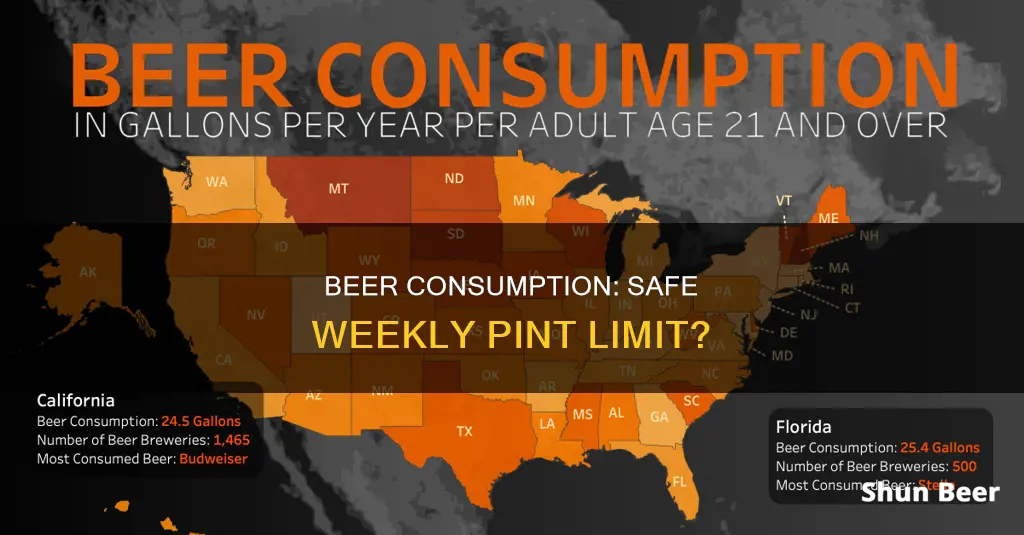
Drinking is a common activity for many people, but how much is too much? Excessive drinking is often categorised as binge drinking or heavy drinking. Binge drinking is defined as consuming enough alcohol to reach a blood alcohol concentration (BAC) of 0.08% or higher, which for men is typically five or more drinks within two hours, and for women is four or more drinks. Heavy drinking is defined as drinking eight or more drinks per week for women, and 15 or more per week for men. While moderate drinking may be linked to certain health benefits, such as a reduced risk of heart disease, excessive drinking can lead to serious health issues, including liver disease, heart disease, stroke, cancer, and mental health problems. According to the NHS, to keep health risks from alcohol at a low level, men and women should not drink more than 14 units a week on a regular basis, which equates to around six pints of beer.
| Characteristics | Values |
|---|---|
| Number of pints per week | 6 |
| Number of units per week | 14 |
| Number of drinks per day for men | 2 |
| Number of drinks per week for men | 14 |
| Number of drinks per day for women | 1 |
| Number of drinks per week for women | 7 |
What You'll Learn

Excessive drinking: Binge drinking and heavy drinking
Excessive drinking is categorised into binge drinking and heavy drinking. Binge drinking is a form of excessive alcohol use and is a significant problem in the United States. It is defined by the CDC as a pattern of drinking that brings a person's blood alcohol concentration (BAC) to 0.08 g/dl or above. This typically occurs when men consume five or more drinks and women consume four or more drinks within two hours. Binge drinking is associated with various short- and long-term health risks, including unintentional injuries, violence, risky sexual behaviours, memory and learning problems, early dementia, organ damage, chronic diseases, gastrointestinal issues, weakened immune system, mental health issues, and more. It is also linked to social and personal problems, including decreased productivity, job loss, financial issues, and relationship difficulties.
Heavy drinking is defined as consuming eight or more drinks per week for women and 15 or more drinks per week for men. This may be spread out over the week and does not necessarily indicate binge drinking. However, above these standard levels, a person's overall consumption is considered high. Heavy drinking increases the likelihood of alcohol use disorder (AUD) and other alcohol-related harms. The risks associated with heavy drinking include acute harms such as falls, medication interactions, and chronic consequences such as AUD, liver disease, heart disease, and cancer.
To reduce the risk of harm from alcohol, it is recommended that adults drink no more than 14 units a week on a regular basis. This equates to approximately six pints of average-strength beer or ten small glasses of lower-strength wine. Spreading drinking over three or more days and incorporating drink-free days into the week can also help to keep alcohol consumption within a safer range.
Binge drinking and heavy drinking can have significant negative consequences on health, safety, and well-being. It is important to drink in moderation and be aware of the risks associated with excessive alcohol consumption.
The Many Shades of Blue Moon Beers
You may want to see also

Health risks: Liver disease, cancer, etc
Excessive alcohol consumption is linked to a range of serious health issues, including liver disease and cancer. Liver disease, specifically cirrhosis, is the most advanced form of alcoholic liver disease. It occurs when healthy liver tissue is replaced with scar tissue, preventing the liver from functioning properly. This can lead to fluid retention, increased blood pressure in the portal vein, and encephalopathy, which can cause insomnia, confusion, and inappropriate behaviour. In addition, cirrhosis increases the risk of developing liver cancer.
The risk of developing liver disease increases significantly for women who consume 30 grams or more of hard alcohol daily over five to ten years, or 50 grams or more daily for men. This translates to about two and one-third shots of hard liquor per day. However, it is important to note that any amount of alcohol consumption can be detrimental to the liver, and there is no safe amount to avoid liver disease.
Alcohol consumption is also associated with an increased risk of several types of cancer. According to the National Institute on Alcohol Abuse and Alcoholism, alcohol is a known human carcinogen. Drinking three or more alcoholic beverages per day increases the risk of stomach and pancreatic cancers, and alcohol consumption at any level is linked to a higher risk of esophageal squamous cell carcinoma.
Moderate to heavy alcohol consumption is associated with a higher risk of head and neck cancers, with heavy drinkers having up to a five-fold increase in risk compared to non-drinkers. Additionally, alcohol intake is correlated with an elevated risk of breast cancer, with light drinkers having a slightly higher risk and heavy drinkers facing a 1.6-fold increase in risk.
Furthermore, excessive drinking can lead to colorectal cancer, with moderate to heavy drinkers having up to a 1.5-fold increased risk. The evidence consistently shows that the more alcohol a person consumes, especially over an extended period, the higher their chances of developing an alcohol-associated cancer.
Domestic vs Imported Beer: What's the Real Difference?
You may want to see also

Alcohol units: How to calculate them
The idea of counting alcohol units was introduced in the UK in 1987 to help people keep track of their drinking. Units are a simple way of expressing the quantity of pure alcohol in a drink. One unit equals 10ml or 8g of pure alcohol, which is roughly the amount of alcohol the average adult can process in an hour.
The number of units in a drink is based on the size of the drink, as well as its alcohol strength. For example, a pint of strong lager contains three units of alcohol, whereas the same volume of lower-strength lager has just over two units.
To calculate the number of units in a drink, you need to know the volume of the drink in litres or millilitres and the strength of the drink in Alcohol by Volume (ABV) percentage. You then multiply these two numbers together, and the answer is the number of units. For example, a 750ml bottle of red, white, or rosé wine with 13.5% ABV contains 10 units of alcohol.
In the UK, the current guidelines for "low-risk" drinking are no more than 2 to 3 units per day for women and 3 to 4 units per day for men, with some alcohol-free days. "Increased risk" drinking is defined as consuming under 50 units per week but more than the recommended levels of 14 to 21 units per week for women and 21 to 28 units per week for men. "High-risk" drinking is classified as consuming more than 50 units of alcohol per week.
It's important to note that these guidelines are specific to the UK and may differ in other countries. Additionally, any amount of alcohol consumed by pregnant women is considered excessive use.
Beers Around the World: A Guide to Varieties
You may want to see also

Guidelines: UK, US, and worldwide
The UK's recommended weekly alcohol limit for men and women is 14 units of alcohol, which equates to around five to six pints of beer at 5% ABV strength. This is one of the lowest recommended upper limits for alcohol consumption worldwide. In the US, the recommended upper limit is 12.3 units for women and 14.6 units for men per week.
In other countries, the recommended upper limits vary. For example, in Ireland, the limit is 21.2 UK units for men, while in Denmark, it is 21, and in New Zealand, it is 19. In Spain, the recommended upper limit for men is much higher at 35 UK units.
It is important to note that these guidelines are not completely safe levels of alcohol consumption. Rather, they aim to keep health risks associated with drinking to a minimum. Binge drinking, which is defined as consuming a certain number of drinks within a short period, typically around two hours, is considered particularly harmful and can lead to acute risks such as falls, burns, car crashes, and memory blackouts.
To put these guidelines into context, a unit of alcohol in the UK is equivalent to 8g of pure alcohol, while in the US, a standard drink or "alcoholic drink equivalent" is defined as any drink containing 14 grams of pure ethanol. This amount is typically found in 12 ounces of regular beer, 5 ounces of table wine, or 1.5 ounces of distilled spirits.
When it comes to pregnancy, the safest approach is to abstain from alcohol completely, as any amount of alcohol consumption during pregnancy can be considered excessive and harmful to the developing fetus.
The Anatomy of a Beer Cask: Understanding Its Parts
You may want to see also

Risky drinking: What it means
Excessive alcohol consumption can have detrimental effects on one's health and well-being. So, what exactly does it mean to engage in "risky drinking"?
Risky drinking refers to a pattern of drinking where an individual consumes too much alcohol too frequently. This typically translates to men having more than four drinks on any given day, and women having more than three drinks within the same time frame. It's important to note that the total number of drinks consumed per week is not the sole determining factor. For instance, drinking seven drinks in one night and abstaining from alcohol for the rest of the week is not equivalent to having one drink every night for a week, even though the total number of drinks is the same. Regularly engaging in heavy drinking is considered risky and can lead to short-term and long-term health consequences.
The negative health effects of risky drinking are significant. Over time, it can damage vital organs, such as the liver, leading to inflammation (alcoholic hepatitis) and potentially life-threatening scarring (cirrhosis). Risky drinking also increases the risk of stroke, cardiomyopathy (damage to the heart muscle), and high blood pressure. Additionally, it has been linked to an elevated risk of developing several types of cancer.
To put the quantity into context, a "standard" drink in the United States contains approximately 14 grams of pure alcohol. This is typically equivalent to 12 ounces of regular beer (5% alcohol), 5 ounces of wine (12% alcohol), or 1.5 ounces of distilled spirits (40% alcohol). It's important to be mindful that different types of beer, wine, and spirits can vary in their alcohol content, with some microbrews containing more than the standard 5%. Therefore, it's crucial to pay attention to the alcohol percentage and adjust consumption accordingly.
To drink responsibly and reduce the risk of alcohol-related health problems, it's recommended to not exceed specific weekly limits. For healthy adult men, it's advised to limit consumption to no more than 14 drinks per week, with no more than four drinks in a single day. For healthy adult women, the recommendation is no more than seven drinks per week, with a maximum of three drinks in a single day. Individuals aged 65 and older, regardless of gender, should also adhere to the limit of no more than seven drinks per week and no more than one drink per day. It's important to note that these guidelines are based on binary sex assigned at birth and not on gender identity.
Beer's Reaction to Containers: A Study
You may want to see also
Frequently asked questions
According to the NHS, drinking no more than 14 units of alcohol a week is considered low-risk drinking. This equates to around six pints of average-strength beer a week. However, it's important to note that there is no safe drinking level, and the less you drink, the lower the health risks.
Drinking more than five pints of beer a week can have negative effects on your health and may shorten your life. Excessive alcohol consumption is linked to an increased risk of stroke, heart failure, fatal aortic aneurysms, and other serious cardiovascular diseases. It can also lead to liver damage, high blood pressure, and an increased risk of certain cancers.
If you regularly drink more than the recommended amount, you can reduce your risk by spreading your drinking over three or more days and having several drink-free days each week. Additionally, drinking less alcohol may help lower your risk of cardiovascular conditions and increase your life expectancy.







